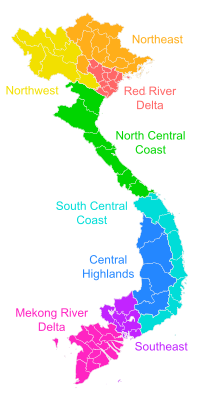
Back Nam Bộ German Vietnam meridional Spanish جنوب ویتنام Persian Viêt Nam méridional French 베트남 남부 지방 Korean Zuid-Vietnam (regio) Dutch Nam Bộ Vietnamese 越南南部 Chinese

Southern Vietnam (Vietnamese: Nam Bộ) is one of the three geographical regions of Vietnam, the other two being Northern and Central Vietnam. It includes 2 administrative regions, which in turn are divided into 19 First Tier units, of which 17 are provinces and 2 are municipalities. In a sub-context, "Southern Vietnam" may include part of Central Vietnam, the two south central costal provinces Ninh Thuận and Bình Thuận are sometimes seen as part of the Southeast region, the Southern. Known as Nam Bộ today in Vietnamese, it was historically called as Gia Định (1779–1832), Nam Kỳ (1832–1945), Nam Bộ (1945–48), and Nam Phần (1948–75).
The origin of Southern Vietnam (Basse-Cochinchine in French, or Lower Cochinchina) was the Kingdom of Funan (from 1st century CE until 6th century CE) and Khmer Empire (from 8th century CE to 17th century). Southern Vietnam was conquered by the Nguyen force in the 17th and 18th centuries from the Khmer kingdom.[1]
The main ethnicities in Southern Vietnam are Kinh, Khmer and Chinese.[2]
- ^ Cooke, Nola (1998). "Regionalism and the Nature of Nguyen Rule in Seventeenth-Century Dang Trong (Cochinchina)". Journal of Southeast Asian Studies. 29 (1): 122–161. ISSN 0022-4634.
- ^ Ho, Hoang-Anh; Martinsson, Peter; Olsson, Ola (2022-03-01). "The origins of cultural divergence: evidence from Vietnam". Journal of Economic Growth. 27 (1): 45–89. doi:10.1007/s10887-021-09194-x. ISSN 1573-7020.
© MMXXIII Rich X Search. We shall prevail. All rights reserved. Rich X Search